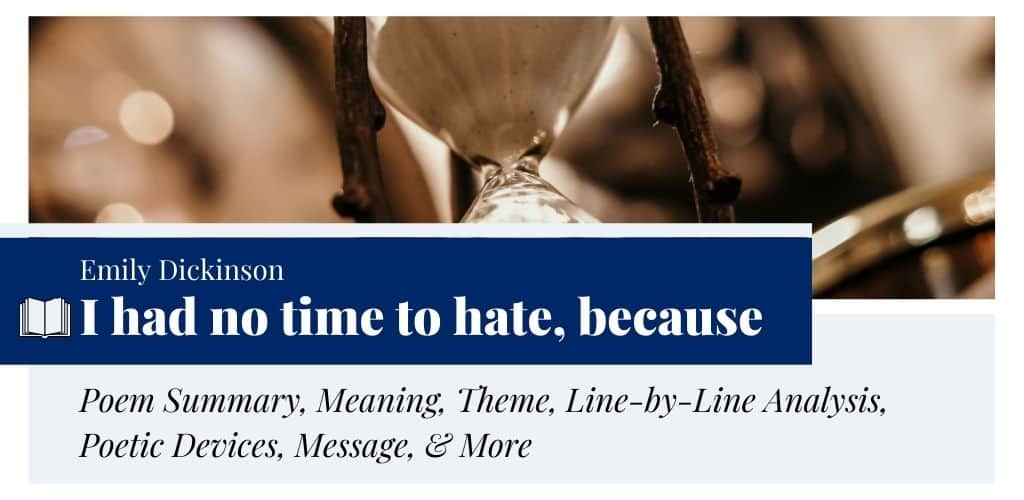I had no time to hate, because by Emily Dickinson
“I had no time to hate, because” is written by one of the best American poets ever, Emily Dickinson. It was first published in Poems (1890) and later in the 1955 scholarly collection of The Complete Poems of Emily Dickinson, a three-volume critical compilation of Dickinson’s poetry, edited by Thomas H. Johnson, “I had no time to hate, because” was the 478 poem of this anthology. The poem is in a simple language with a complex structure (the original version greatly differs from the 1890 version) and meaning. It deals with the theme concepts of love, hate, the brevity of life, death, and the afterlife, significant themes in most of Dickinson’s poetry.
- Read the full poem, “I had no time to hate, because” below:
I had no time to hate, because by Emily Dickinson I had no time to hate, because The grave would hinder me, And life was not so ample I Could finish enmity. Nor had I time to love; but since Some industry must be, The little toil of love, I thought, Was large enough for me. - from Poems (1890)

Summary
“I had no time to hate, because” by Emily Dickinson deals with the inner thought of a speaker. Though Dickinson uses the first-person pronoun, “I,” she makes each reader substitute the persona for themselves within the text. The speaker of this poem says that life is short to hold grudges and to hate. Instead, one should use the time of their lives to love and to be fruitful.
In the second stanza, the speaker contradicts her idea of finishing enmity as death would not allow her to do so. According to her, she neither had time to love as it is, indeed, a laborious task—a skillset she lacks. Hence, the “little toil of love” seemed a gigantic task to her.
Meaning
Dickinson’s “I had no time to hate, because” explores various concepts such as the brevity of life, the inevitability of death, choices, and love versus hatred. This poem shows how the speaker takes control of her thoughts rather than falling under their control. As for her, she had no time to hate or love. Instead, she chose the “little toil of love” and to “finish enmity” because she felt that the brevity of life would not allow her to indulge in such emotions.
Besides, the speaker makes the readers aware of the consequences of hating or loving someone implicitly. She leaves the right of choice up to the readers. Though she seems to be fully prepared in life, the fact that she has to die one day is a little frightening for her. She implies that life is all about sharing and caring and finding love other than holding on to the past grudges. Overall, the poem tells readers to move forward and be grateful for what they have rather than complaining and whining.
Form, Rhyme Scheme, & Meter
Form
Dickinson’s poems are known for the use of short lines, unusual punctuations, capitalizations, and slant rhymes – which are evident in “I had no time to hate, because.” It has short lines divided into two quatrains, stanzas having four rhyming lines each. Dickinson uses the first-person point of view and past tense to reflect on the choices she made in her life. In this poem, the value of life and the importance of using the time of life in loving rather than hating are emphasized in both the stanzas. Alongside that, the use of a regular rhyme and meter makes this piece a beautiful lyric poem.
Readers can find Dickinson’s trademark features in the 1955 version of the text. In the actual version, she used capitalization in order to emphasize particular words, specifically nouns, that include “Hate,” “Grave,” “Life,” “Enmity,” “Love,” etc. Read the full text of the 1955 version, “I had no time to Hate—” below:
I had no time to Hate— (478) by Emily Dickinson I had no time to Hate— Because The Grave would hinder Me— And Life was not so Ample I Could finish—Enmity— Nor had I time to Love— But since Some Industry must be— The little Toil of Love— I thought Be large enough for Me— - from The Complete Poems of Emily Dickinson (1955)
Rhyme Scheme
The overall rhyme scheme of the poem is ABCB. It means the second and fourth lines end with a similar rhyme in each quatrain. For instance, in the first stanza, “me” closely rhymes with “enmity.” In the following stanza, “be” and “me” form a perfect rhyming pair.
Meter
Dickinson composed this poem using iambic tetrameter and iambic trimeter, alternatively. The first and third lines have 8 syllables, and there are 6 syllables in the second and fourth lines. Readers have to stress the second syllable leaving the first one unstressed. Let’s have a look at the scansion of the poem:
I had/ no time/ to hate,/ be-cause
The grave/ would hin/-der me,
And life/ was not/ so am/-ple I
Could fi/-nish en/-mi-ty.
Nor had/ I time/ to love;/ but since
Some in/-dus-try/ must be,
The lit/-tle toil/ of love,/ I thought,
Was large/ e-nough/ for me.
Poetic Devices
Every poem has its own beauty, but the use of poetic devices makes it more appealing and artistic. Similarly, Dickinson uses a number of poetic devices to make “I had no time to hate, because” more aesthetically pleasing. The poetic devices used in this piece include:
- Metaphor: When two different things are compared and said to denote the same meaning, that is called metaphor. In this poem, Dickinson uses the phrase “the little toil of love” where “toil” does not mean to work day and night; instead, it means that love needs to be taken care of. One must work hard mentally, not physically.
- Personification: When a human trait is given to a non-living thing, it is called personification. In this poem, the line, “The grave would hinder me,” feels like the grave, in real, standing in the speaker’s way. However, she means that the thought of her impending death will obstruct her from hating others.
- Symbolism: Poets use this device to expand their thoughts and associate different ideas to specific terms. In “I had no time to hate, because,” the poet uses symbols of “grave” and “industry” to indicate the ideas of death and particular, skill respectively. The term “industry” also symbolizes the continuous process of loving someone or life itself.
- Consonance: It occurs in “I had no time to hate,” “And life was not so ample,” “Nor had I time to love,” “The little toil of love,” etc.
- Enjambment: The poet uses this device across the text; for instance, it occurs in lines 1-2 and 3-4: “I had no time to hate, because/ The grave would hinder me,” and “And life was not so ample I/ Could finish enmity.”
- Irony: The irony is that the speaker says she has no time to hate or love. Yet, at the same time, she says that “little toil of love” is “large enough” for her. Though she has no time, she is ready to be engrossed in a “little toil.”
Line-by-Line Analysis & Explanation
Lines 1-4
I had no time to hate, because
The grave would hinder me,
And life was not so ample I
Could finish enmity.
Dickinson’s poem “I had no time to hate, because” depicts that life is short and unpredictable to cherish hatred for others. The speaker says that she could choose to fuel her hatred, but the thought of “grave,” a metonym for death or for the inevitability of death, the thought of hate seemed useless and meaningless. She believes there is nothing more to carry forward after death. Once the body dies, everything is counted as waste and unworthy, including emotions.
In the following lines, the speaker says that life is not enough to end enmity. One cannot keep the feelings of enmity alive for long. There are a lot of reasons in life to feel enmity. To act upon past grudges is not a sustainable way to lead one’s life. Hence, the speaker utilized the ample time of her life in something productive, like writing poetry.
Lines 5-8
Nor had I time to love; but since
Some industry must be,
The little toil of love, I thought,
Was large enough for me.
In the second stanza, the speaker accepts the fact that life is not enough for love either, still loving is better than hating. A little hard work in improving our relationships can make life worth living. Although Dickinson is not a fan of conventional love, she prefers it as it is better than simply wasting time in enmity.
The word “industry” in the second line indicates the special skill set required to master the art of living, which the speaker lacks. It can be a reference to the continuous process of loving someone. The toils of keeping a relationship alive are compared to raw materials used as input in the industry.
Finally, the speaker says that the “little toil of love” is enough for a whole lifetime. In these lines, the speaker contradicts her remark, “to love” is “Some industry must be.” She rejects the idea of loving someone throughout her life and enduring the pain originating from the relationship. Thus, she chose not to love just like she refrained from hating. She thought the “little toil” required was “large enough,” which needed sacrifice.
Theme
Most of Dickinson’s poems deal with the theme of immortality, death, love, life, and nature. Her poem, “I had no time to hate, because” especially revolves around the theme of love and hatred, the brevity of life, the inevitability of death, and the afterlife. The themes are well structured and depicted in the poem. For instance, in the first two lines, Dickinson depicts how the inevitability of death makes her realize that there is little time in her life to hate. In the next lines, she focuses on the brevity of life that would not allow her to end hostility.
There is a clear shift in the opening of the second stanza. In the beginning, the speaker highlights how tough it is to cherish love. While, in the following lines, she ironically portrays how she chooses not to love as it seems a gigantic task for her. In this way, she criticizes the conventional approach to cherish love more than one’s individual choices.
Message
The message that the poem tries to convey is, it is useless to spend the valuable time of our lives hating others. Instead, we should start utilizing the rest of our lives loving and encouraging others to love. Life is too short and what holds tomorrow is unknown, so it is better to forgive our enemies and move forward with love in our hearts by putting a smile on our faces. The main point is life is not long enough to hold on to past grudges and enmity. Instead, it is short and unpredictable. No one knows what tomorrow holds. So we must invest our spare life in more meaningful pursuits, such as spirituality and creativity.
Questions & Answers
Emily Dickinson’s poem “I had no time to hate, because” provides the message of making the right choices and knowing the consequences of the choices we make. Life only has a meaning when we live to love and spread love, instead of wasting our precious time in enmity.
In “I had no time to hate, because”, Dickinson says that “enmity” ends after one dies. As she says in the last lines of the first quatrain, life is not so ample to end enmity. If we choose to make enemies, there is no end to it. On top of that, it is easier to make enemies than lifelong friends. So, it is up to the readers whether they want to finish enmity or not.
This poem suggests that the speaker has faith in the Christian idea of the afterlife. She believes that there is a new beginning after death, and all the hateful emotions will not be carried forward in the afterlife. The fire of enmity in her heart will be extinguished in the grave.
The poem deals with several themes that include love versus hate, choices, the brevity of life, the inevitability of death, the afterlife, and time. In this poem, the poet says that she has no time to hate or love due to the brevity of life.
Dickinson uses several literary devices in the poem. These include alliteration, metaphor, enjambment, personification, and irony.
The first two lines of the poem hint at the ideas of the brevity of life, the futility of hatred, and the inevitability of death. Through these lines, the speaker says that she had no time to hate someone as the idea of death would hinder her.
Historical Context
Emily Dickinson (1830-1886) is one of the most influential American poets of all time. Only 10 poems out of 1800 were published during her lifetime. She became famous only after her death when her sister found a pile of her poems worthy of publishing. Four years after her death, Dickinson’s first volume of poetry, Poems (1890), was published. Later in 1955, the first scholarly edition, The Complete Poems of Emily Dickinson, was published by Thomas H. Johnson. The poem “I had no time to hate, because” appears in the first section (Book I: “Life”) of Poems and as the 478 number poem in Johnson’s collection. It was composed around 1862, one of the most creative years in Dickinson’s life.
Similar Poems about Love, Hatred, & Death
- “Spring” by Edna St. Vincent Millay — In this poem, the hostility in a speaker’s heart makes her scorn the beauty of the spring.
- “If you were coming in the Fall” by Emily Dickinson — In this piece, Dickinson’s speaker explores the uncertainty of her lover’s return and the brevity of life.
- “Our revels now are ended” by William Shakespeare — This speech from The Tempest, regarded as the “retirement speech” of Shakespeare, taps on the brevity of life and the inevitability of death.
- “The Heart asks Pleasure—first—” by Emily Dickinson — This poem shows how one can break the cycle of pleasure and pain by death.
External Resources
- Emily Dickinson and Death — Explore how Dickinson deals with this theme in her poems.
- Dickinson’s Love Life — Read about the love life of the poet and why she chose to lead a secluded life.
- About Emily Dickinson — Learn about the poet’s life, writing career, and posthumous success.
- Poet Profile & Poems of Emily Dickinson — Explore more about the poet and read some of her best-known poems.






